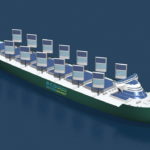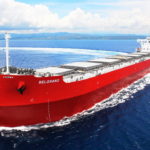Eco Marine Power (EMP) promotes its renewable energy project »Aquarius« for several years now. However, now founder Greg Atkinson sees a major hurdle being cleared, expecting first sea trials of a rigid sail and solar power system during next year
Until now, the project was presented at several occasions. Scepticism about this quite futuristic looking technology predominated in the industry[ds_preview]. Nonetheless Atkinson did not tire to underline the potentials and capabilities.
Not surprisingly he is very satisfied to speak about a recent development: Fukuoka-based EMP announced that it has begun preparing for sea trials of its Aquarius Marine Renewable Energy (MRE) solution in co-operation with strategic partners and ship owner Hisafuku Kisen K.K. of Onomichi, Japan. EMP revealed that this preparatory work will lead to what it calls »the world’s first installation of an integrated rigid sail and solar power system for ships using EMP’s patented technologies including the EnergySail«. Atkinson expects the trials to result in the wider deployment of EMP’s solutions on ships ranging from coastal cargo vessels to bulk ore carriers and cruise ships.
Currently underway is a feasibility study involving several large bulk carriers including the »Belgrano«, »Nord Gemini« and »Bulk Chile«. For each ship an estimate of the propulsive power that could be provided by an EnergySail array will be prepared according to the routes they operate on. In addition the total amount of solar power that could be installed on each vessel will be determined. On-board testing & data collection will also be undertaken as required.
According to the plan after the feasibility study is completed, one ship will be selected for the sea trials phase. During this phase a trial configuration that will incorporate all the elements of Aquarius MRE will be installed and evaluated during a period of approximately 12 to 18 months.
Aquarius MRE is an integrated system of rigid sails, marine-grade solar panels, energy storage modules and marine computers. The use of these alternative sources of power and propulsion will reduce fuel consumption, lower air pollution and cut CO2 emissions. The rigid sails used by Aquarius MRE are based on EMP’s EnergySail technology. These renewable energy devices can even be used when a ship is at anchor or in harbour. Each EnergySail can be configured with a mix of sensors, photovoltaic panels or other power generation devices.
Asked, when he expects the first vessel sailing his system in regular service, Atkinson tells HANSA, »the full commercial system will be ready around 2020 so sometime after that we would expect the first ship to be operating with Aquarius MRE fitted.«
A number of strategic partners are involved in the Aquarius MRE Project including KEI System, Furukawa Battery Company and Teramoto Iron Works. EMP is also in discussions with several companies including potential investors about their possible involvement in the project. »In addition to investors, we are seeking technical partners that might be able to supply complimentary technologies including on-board DC grid, low power DC lighting and power management systems«, Atkinson tells HANSA.
Commenting on this latest development he adds: »It’s great that we are able to co-operate with Hisafuku Kisen and we very much appreciate their cooperation in helping us move this important project towards sea trials.« Chikashi Yamane, President of Hisafuku Kisen, stated. »Our company is pleased to be part of this exciting project which is leading the way towards the use of renewable energy related technologies on ships.«
The production of each EnergySail to be used during the sea trials will be undertaken at the workshops of Teramoto Iron Works in Onomichi. This company was also involved in the production of rigid sails in the 1980’s and has extensive experience regarding the manufacturing of high quality marine fittings for ships.
In the 1980’s several Japanese ships were fitted with rigid sails with the aim of reducing fuel consumption. This was driven largely by the oil crisis in the 1970’s which resulted in oil shortages and the price of oil soaring. However the oil crisis passed and when oil prices fell in the 1980’s the viability of rigid sails in terms of cost was undermined.
However Japanese ships such as the »Shin Aitoku Maru« and »Usuki Pioneer« which were fitted with JAMDA (Japan Machinery Development Association) rigid sails, did prove that rigid sails reduced fuel consumption. More than a dozen ships were fitted with these JAMDA sails.
Today the amount of potential savings depends on »a few variables such as the ship type, the route it operates on and the operating profile of the ship«, Atkinson explains, adding »however our aim is to provide a system that can reduce fuel consumption by around 10% annually. Theoretically higher fuel savings can be achieved through the use of larger sails (20m or higher) but our research indicates that the use of large sails on most modern powered commercial ships is not feasible.« 8% could be saved by sails and 2% from solar.
Although the system was initially designed for large ships, much of the associated technology might also be suitable for smaller vessels such as coastal freighters, passenger ferries and tourist boats. A study is also being conducted to determine if it would be feasible to use the system on naval and government vessels such as patrol ships. EMP says elements of the system are also suitable for autonomous surface vessels (ASV’s) and unmanned surface vessels (USV’s).
The rigid sail – made from marine grade steel or a carbon fibre composite material or both – is moved automatically by the computer control system to best suit the prevailing weather conditions. Each sail may also be fitted with other power generating devices and sensors. They can also be lowered when a ship is loading/unloading cargo or during storms, it is said. The collected energy from the solar panels can be stored in batteries. The batteries when charged can then be used to power the ship’s operational equipment or alternatively, be used as a power source when at harbour or at anchor.
MM




















